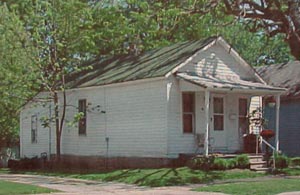Even More on the Shotgun House (Further comment from Dr. Gilderbloom)
 Shotgun house in the Jackson/Monroe Historic District (Charleston). From Association for the Preservation of Historic Coles County.
Shotgun house in the Jackson/Monroe Historic District (Charleston). From Association for the Preservation of Historic Coles County.In the meantime, I talked to Gary Waltrous, AIA (www.sunearth.net) , an architect with a specialization in energy design. He says that the origins of the shotgun house are from Africa, first coming to the Caribbean islands as part of the slave trade and perhaps finding their first American location in New Orleans (or Charleston).
He says that these shotguns were pre--electric and designed to cool using trade winds and cross ventilation with windows on all four sides, high celiings and the shotgun lifted up by two to three feet by piers--this also helped cool the house and gave some protection against flooding. So in terms of sustainable design, the shotgun trumps the ranch and the manufactured house.
The ranch style house, the square box, does not afford good opportunities for cross ventilation and depends more on energy gas and electric to cool it. It also more expensive to build. I should do one important correction, we built the shotgun houses with all new appliances for a cost of around $45,000, assuming a thirty year mortgage would be about $246.29 after $5,000 was put down. In terms of housing affordability, this seems pretty good deal.
I do not agree with some of my liberal friends who contend that rebuilding shotguns equals rebuilding the ghetto. Not all neighborhoods with shotguns are ghettos--that is a stereotype--some have a good mix of low, moderate and high income housing. Check out in Louisville--the upscale Highlands, Butchertown, Old Louisville, Russell. The nice thing about building shotguns at $45,000 a shot is that a household earning a minimum wage could afford these homes at $246 a month.
_________
Re: Mr. Waltrous' comments about the origin of the shotgun house, also see: John Michael Vlach. "Afro-Americans." America's Architectural Roots, Ethnic Groups that Built America. Washington, D.C.: The Preservation Press: National Trust for Historic Preservation, 1986. p 43.
Re: the neighborhoods in Louisville that are replete with Shotgun houses, the ones Dr. G mentions as well as the Clifton neighborhood where I stayed for a couple days...he's absolutely right, these are great neighborhoods with residents of a variety of income levels, and definitely affordable houses. I recall Clifton houses of 2,000 s.f., being under $200,000, and that neighborhood recently became a historic district, and is pretty close to Cherokee Triangle and the hip area of Frankford Avenue.
And about Butchertown...if you walk on the back side of the packing plant, you can truly smell the cattle.



0 Comments:
Post a Comment
<< Home